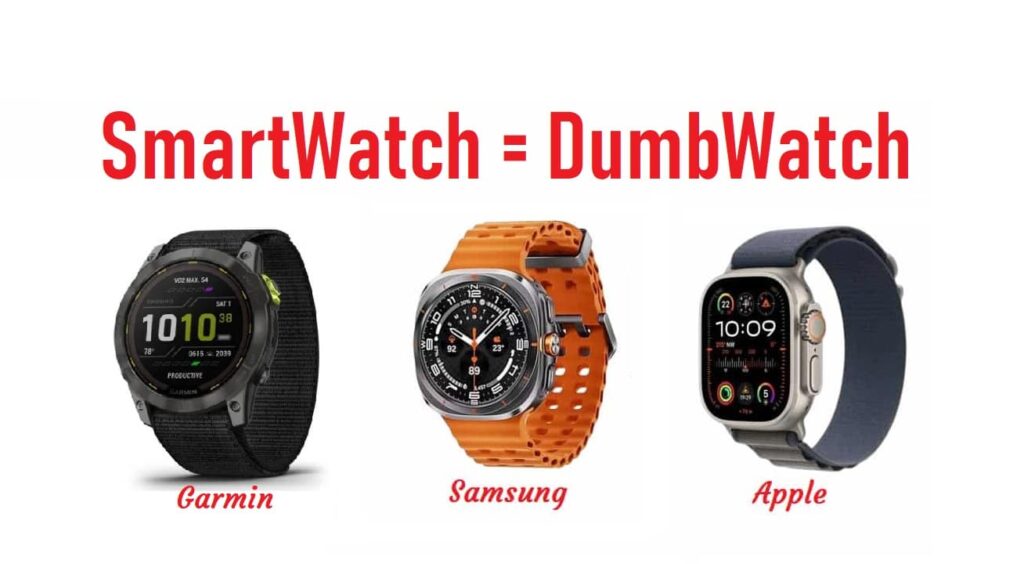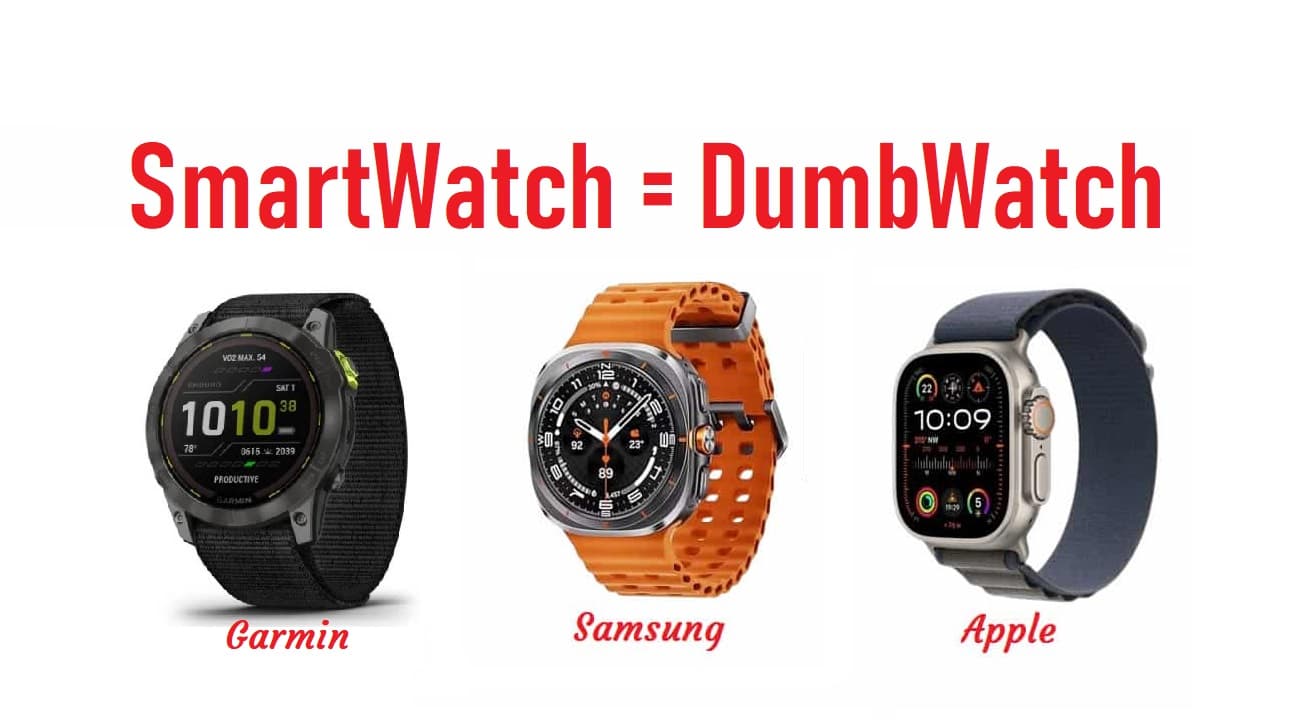Key Takeaway: Choosing between an Apple Watch and a Garmin for your workouts can be challenging. Understanding how each performs in real-world scenarios can help you make an informed decision. This guide will break down the ease of starting workouts, tracking your data, and what you should consider for a smooth fitness experience.
When it comes to tracking workouts, both Apple and Garmin offer powerful features, but they do so in different ways. Whether you’re training for marathons or just trying to stay fit, understanding how these watches compare in everyday use can save you from frustration and help you get the most out of your device.

Starting Your Workout: Garmin vs. Apple Watch
Garmin Watches
Garmin watches are designed with ease of use in mind, especially when starting a workout. Here’s how they make the process straightforward:
- Simple Controls: Most Garmin watches come with a physical start/stop button. To start a workout, you just press this button, and you don’t even have to look at the screen. Once you choose your workout type, you simply wait for the GPS signal and press the button again to start.
- Feedback and Alerts: Garmin watches provide both audio and haptic feedback when starting or stopping a workout. This means you get a gentle vibration and a sound alert, so you don’t need to constantly check the screen.
- Hardware Buttons: The use of physical buttons makes the process intuitive. You can scroll through options and start workouts without needing to navigate through a touchscreen, which can be especially useful if you’re on the move.
Apple Watch
Apple Watches, particularly the newer Ultra models, offer a different experience:
- Touchscreen Navigation: For most Apple Watches, you start a workout by opening the workout app on the touchscreen. You scroll to find your workout type and tap to select it. For the Ultra models, you can use the action button to start the workout once the GPS signal is ready.
- Action Button: On the Apple Watch Ultra, the action button is a convenient feature that can start a workout directly. However, for Series and SE models, you’ll need to tap the screen or use the two side buttons to start or stop your workout.
- Countdown Feature: Some Apple Watches have a countdown timer that activates when you start a workout. This can be useful for precise starts but may add a step that Garmin’s simpler approach avoids.
Which Is Easier?
Garmin watches generally offer a more straightforward approach to starting workouts with physical buttons and immediate feedback. If you prefer not to fiddle with a touchscreen, Garmin’s system might be more user-friendly. On the other hand, Apple’s newer models, like the Ultra, provide advanced features and a more modern interface, though they might involve more steps to start and stop workouts.
Tracking and Viewing Your Workout Data
After starting your workout, it’s crucial to track and review your data efficiently. Here’s how Apple and Garmin compare in this aspect:
Garmin Watches
- Real-Time Data: Garmin watches display key metrics on the screen during your workout. You can customize the data fields to show the information most relevant to you, like pace, distance, and heart rate.
- Data Review: Post-workout, Garmin provides detailed summaries and historical data. The interface is designed to give you a comprehensive view of your performance, making it easy to analyze your progress.
- User Experience: Garmin’s ecosystem, including the Garmin Connect app, integrates well with the watches to offer in-depth analysis and insights. It’s tailored for users who want detailed statistics and historical tracking.
Apple Watch
- Workout Metrics: Apple Watches also provide real-time data during your workout. The information is displayed clearly on the screen, but the customization options might be less flexible compared to Garmin.
- Post-Workout Analysis: After completing your workout, the Apple Watch syncs data with the Fitness app on your iPhone. This app provides an overview of your performance, including metrics like heart rate, calories burned, and distance.
- Integration with Health App: Apple’s Health app collects data from various sources, including the Apple Watch. This integration offers a holistic view of your health and fitness, though it might not be as detailed as Garmin’s offerings for serious athletes.
Which Is Better?
Garmin tends to excel in providing detailed, customizable data and is preferred by those who want in-depth analysis. Apple Watches offer a more integrated experience with iOS devices and provide a user-friendly interface, which might be more appealing for casual users who value simplicity.
Common Issues and Troubleshooting
Both Garmin and Apple Watches have their quirks, which can sometimes lead to frustration:
- Garmin Issues: Occasionally, Garmin watches might restart unexpectedly or face GPS connectivity problems. These issues are generally rare but can be annoying during important workouts.
- Apple Watch Issues: Some users report glitches like the “orange screen of death,” where the watch vibrates as if starting a workout but doesn’t actually begin tracking. This can be disheartening if you rely on the watch’s feedback.
Tips for Avoiding Problems
- Keep Software Updated: Regularly update your watch’s firmware to fix bugs and improve performance.
- Restart Your Watch: If you encounter persistent issues, restarting the watch can often resolve minor glitches.
- Check GPS and Connectivity: Ensure your watch has a good GPS signal before starting a workout and that it’s connected to your phone if needed.
Final Thoughts
Both Garmin and Apple Watches have their strengths when it comes to tracking and starting workouts. Garmin shines with its intuitive physical controls and detailed data analysis, making it a top choice for serious athletes. Apple Watches offer a sleek design and integrated experience with iOS, ideal for users who appreciate convenience and a modern interface.
Ultimately, the best watch for you depends on your personal preferences and fitness goals. If you value simplicity and tactile feedback, Garmin might be your best bet. If you prefer a seamless connection with your iPhone and a stylish design, an Apple Watch could be the right choice.
Hardware Integration: Apple Watch vs. Garmin
Garmin’s Advantage
1. Easy External Device Connection: Garmin shines when it comes to connecting with external hardware. Whether you’re using heart rate straps, foot pods, or body temperature sensors, Garmin makes it easy to see whether these devices are connected before you start your workout. For instance:
- Heart Rate Monitors: Garmin watches can easily pair with various heart rate straps, including Polar’s and Garmin’s own.
- Foot Pods: Devices like the Stryd Foot Pod work seamlessly with Garmin watches for accurate distance and pacing metrics.
- Temperature Sensors: If you’re monitoring heat strain, Garmin supports core body temperature sensors effortlessly.
You’ll notice indicators on the Garmin watch’s screen for connected devices, like flashing icons for your heart rate strap or foot pod. This real-time feedback ensures you’re all set before you begin your workout, reducing the risk of any surprises during exercise.
2. Integrated Setup: Garmin’s interface allows you to check device connections quickly and resolve any issues within the settings. This streamlined process can save you time and frustration, especially if you rely on multiple sensors for your workouts.
Apple Watch’s Approach
1. Manual Connection Checks: Apple Watches, while versatile, require a bit more manual effort to ensure all your external devices are connected. Here’s how it works:
- Heart Rate Monitors: If you’re using a heart rate monitor with your Apple Watch, you need to check its connection by navigating through the watch’s settings. You’ll need to go to Bluetooth settings, scroll to health devices, and ensure everything is properly connected. This extra step can be cumbersome, especially if you’re in a hurry to start your workout.
2. Foot Pods and Sensors: Apple Watch supports Stryd Foot Pods and other sensors, but you’ll often need to use specific apps for this. For example, you might have to open the Stryd app rather than using the default workout app to get accurate data. This added step can complicate the process compared to Garmin’s more integrated approach.
Custom Workouts: Apple Watch vs. Garmin
Garmin’s Custom Workout Features
1. Seamless Integration with TrainingPeaks: Garmin watches sync effortlessly with TrainingPeaks and similar apps. Here’s how it works:
- Workout Syncing: Your coach can send custom workouts directly to your Garmin watch. You’ll receive notifications about workout details, including distance, pacing, and timing.
- Visual Guidance: Garmin’s display shows detailed workout plans, including pacing targets, which are visually easy to follow. For example, you might see a dial showing your required pace, with notifications if you’re falling outside your target zone.
2. On-the-Go Adjustments: Garmin watches offer real-time feedback on your workout progress. This feature is handy for adjusting your pace or making changes based on how you’re feeling during the run.
Apple Watch’s Custom Workout Features
1. Integration with TrainingPeaks: Like Garmin, Apple Watch can sync with TrainingPeaks, but the process is slightly different:
- Workout Notifications: You’ll receive workout details on your Apple Watch, including distance and pacing targets. However, the watch primarily focuses on distance during workouts, which might not be as detailed as Garmin’s pacing guidance.
2. Display and Interaction: The Apple Watch provides a streamlined experience but with some limitations:
- Pacing Visibility: During workouts, Apple Watch shows pace information primarily at the start. You might not have continuous visual cues on your pacing for the entire workout, which can be less helpful if you need real-time adjustments.
3. Manual Adjustments: If you need to change workout settings or check connections, the Apple Watch requires navigating through multiple screens, which can be less convenient compared to Garmin’s more integrated interface.
Touch Screen Responsiveness
Apple Watch: Smooth and Intuitive
1. Responsive Touchscreen: The Apple Watch’s touchscreen is highly responsive, much like using an iPhone. This means swiping, tapping, and scrolling feel smooth and natural.
- Example: When adjusting settings or navigating through workout screens, the Apple Watch’s touchscreen provides immediate feedback, making it easy to use even while moving.
2. Potential for Accidental Presses: Despite its excellent responsiveness, the Apple Watch can be prone to accidental presses, especially during intense workouts or when you’re sweaty. Long sleeves and sweat can sometimes lead to unintended pauses or changes in your workout.
Garmin: Slight Lag but Functional
1. Touchscreen Performance: Garmin’s touchscreens tend to have a slight lag compared to the Apple Watch. They feel a bit less responsive, similar to using an Android device compared to an iPhone.
- Example: Navigating through menus or changing settings on a Garmin might feel a bit sluggish, but it generally gets the job done.
2. Automatic Screen Lock: One of Garmin’s strengths is its automatic screen lock feature that activates when you start a workout. This prevents accidental presses caused by sweat or movement.
- Example: If you’re running a marathon and your hands are sweaty, the Garmin’s screen will remain locked, avoiding unwanted changes to your workout data.
Handling Accidental Presses During Workouts
Apple Watch: Manual Water Lock Feature
1. Water Lock Mode: To prevent accidental presses, the Apple Watch offers a Water Lock mode. Activating this mode from the control center locks the touchscreen but allows you to use physical buttons like the Digital Crown and action button.
- Example: Before starting a sweaty workout, you can turn on Water Lock to ensure your touch screen doesn’t pause or alter your workout. This feature is especially useful if you’re wearing long sleeves or if you tend to sweat a lot.
2. Real-Life Scenario: I once ran a half marathon without activating Water Lock, and my workout was interrupted by sweat and long sleeves. I ended up with an incomplete workout on Strava, which was frustrating. Since then, I always remember to activate Water Lock to avoid similar issues.
Garmin: Built-In Solution
1. Automatic Lock: Garmin watches automatically lock their screens once you begin a workout, which helps prevent accidental presses from sweat or movement.
- Example: You can start your run or bike ride without worrying about accidentally pausing your workout. The screen will remain locked, allowing you to focus on your exercise without interruptions.
2. No Additional Steps Needed: Unlike the Apple Watch, you don’t need to manually activate a water lock feature on Garmin watches. This built-in feature ensures that accidental presses are less of a concern.
Comparing User Experiences
Apple Watch: High Responsiveness, Some Trade-Offs
1. Pros: The Apple Watch’s touchscreen is highly responsive and feels like using a high-end smartphone. It’s great for quick interactions and detailed navigation.
- Example: Adjusting settings or checking data during a workout feels fluid and intuitive.
2. Cons: The lack of an automatic screen lock means you might face interruptions during intense workouts, especially if you’re sweaty or wearing long sleeves.
Garmin: Practical and Functional
1. Pros: Garmin’s automatic screen lock feature is practical for avoiding accidental presses, making it a good choice for intense or long-duration workouts.
- Example: The screen lock ensures that your workout data remains consistent and unaffected by sweat or movement.
2. Cons: The slight lag in touchscreen responsiveness can be a drawback, especially if you prefer a more immediate touch experience.
Conclusion
When deciding between the Apple Watch and Garmin for your workout needs, consider how you interact with the touch screen and how often you experience accidental presses.
- Apple Watch: Offers a highly responsive touchscreen and a user-friendly interface, but requires manual activation of Water Lock to prevent interruptions during workouts.
- Garmin: Provides automatic screen locking to prevent accidental presses, which is especially useful if you tend to sweat a lot or prefer not to worry about screen interactions during exercise. However, the touchscreen may feel less responsive compared to the Apple Watch.
Battery Life Comparison: Apple Watch vs. Garmin
Garmin Watches
Garmin watches are renowned for their impressive battery life, making them ideal for long workouts and adventures. Here’s what you need to know:
- Extended Battery Life: Garmin watches can last up to 21 days on a single charge, depending on your settings. This longevity makes them perfect for multi-day trips or ultra-endurance events. When using GPS, the battery can last up to 44 hours, which is fantastic for marathon runners and those who love long-distance activities.
- Maximum Accuracy: If you’re aiming for the highest accuracy in your tracking, Garmin watches are designed to provide extended battery life without frequent recharges. This means you can go for weeks without worrying about running out of power.
- Charging Experience: Garmin’s charging method can be a bit cumbersome. You need to find the charging port and ensure the cable is properly connected. This can be less convenient compared to magnetic chargers and might be a hassle if you’re on the go.
Apple Watch
Apple Watches offer a different approach, focusing on convenience and user-friendly features. Here’s how they stack up:
- Battery Life: The latest Apple Watch Series 8 and Series 9 can last through a half marathon, and possibly a full marathon depending on settings. The Apple Watch Ultra is designed to handle ultra marathons but might require low power mode for extended use. Generally, you can expect the Apple Watch Ultra to last about a day and a half on a single charge.
- Charging Ease: Charging an Apple Watch is quite simple and efficient. The magnetic charging dock allows you to easily attach the watch and start charging without fuss. A 30 to 45-minute charge during daily routines can keep your watch powered up and ready.
- Daily Habit: For Apple Watch users, maintaining a charging routine is essential. You might need to adapt to charging your watch daily or at least every other day. This regular charging can be easily integrated into your routine, especially if you’re used to charging your phone or other devices.
Which Is Better for You?
Garmin Watches are ideal if you prioritize battery life and long-lasting performance. With up to 21 days of power and extensive GPS usage time, Garmin is a strong contender for endurance athletes and frequent travelers who need their watch to last without constant recharging.
Apple Watches excel in convenience and ease of use. The magnetic charger is quick and simple, making it easy to top up your watch as part of your daily routine. While the battery life may not match Garmin’s extended duration, the ease of charging and advanced features might be worth the trade-off for many users.
Real-Life Scenarios
For Daily Use and Short Workouts
If your daily workouts are relatively short and you use your watch frequently for various activities, an Apple Watch may be more suitable. The convenience of magnetic charging and integration with your iPhone offers a seamless experience. You’ll likely find it easy to maintain a charging habit as part of your daily routine.
For Extended Adventures and Long-Distance Training
For those who embark on long adventures or train for ultra-marathons, Garmin’s extended battery life is a significant advantage. You won’t have to worry about running out of power during long runs or hikes. The occasional hassle of connecting the charging cable may be worth it for the assurance of prolonged usage.
Common Charging Issues and Solutions
Both Apple and Garmin watches have their quirks when it comes to charging:
- Garmin: The charging port can sometimes be finicky. Ensure the cable is securely connected, and consider carrying a spare charger if you’re traveling.
- Apple Watch: If the magnetic charger doesn’t seem to be working, make sure the watch is properly aligned with the charger. If you’re still facing issues, check for any debris or obstructions that might be interfering with the connection.
Tips for Managing Battery Life
- Monitor Usage: Keep track of your battery usage and settings to ensure you’re getting the most out of your watch. Adjusting power modes or turning off non-essential features can extend battery life.
- Keep Chargers Handy: If you’re traveling or have a busy schedule, always keep a charger with you. A portable charger can be a lifesaver for both Apple and Garmin watches.
- Regular Maintenance: Regularly clean the charging contacts on both devices to ensure a reliable connection and efficient charging.
GPS Accuracy: Apple Watch vs. Garmin
Apple Watch: Smoother but Less Precise
1. Data Smoothing: The Apple Watch is known for smoothing out its GPS data. This means the lines on your running map are usually straighter, and the pace readings are less jagged. While this smoothing can make your data look cleaner, it sometimes leads to inaccuracies in distance tracking.
- Example: During a recent run, the Apple Watch recorded a shorter distance than actually covered, especially in complex areas like piers or boardwalks. This smoothing might cause the watch to cut corners or make less precise distance measurements.
2. Map Visualization: After your workout, the Apple Watch shows a text-based summary of your data. You’ll get detailed information on distance, average pace, and other metrics. While functional, it lacks the visual flair of Garmin’s post-workout maps.
Garmin: Detailed but Jagged
1. Real-Time Accuracy: Garmin watches provide detailed GPS tracking with less data smoothing compared to Apple Watch. This means you get more granular data, which can be especially useful for analyzing specific aspects of your run.
- Example: Garmin’s GPS tracking might show more jagged lines on the map, but this can be beneficial for accurately mapping your path, especially in areas with complex terrain.
2. Post-Workout Visualization: Garmin offers a visual map of your run once you finish. This map can be shared easily on social media, showcasing your route and distance with a clear graphical representation. It’s a great way to share your achievements and visualize your runs.
Performance on Different Terrains
Treadmills vs. Outdoors
1. Treadmill Runs: Both watches can struggle with treadmill runs due to the lack of GPS signal. This is where the differences become more pronounced. Apple Watch may display more significant deviations from actual distance, while Garmin might provide more consistent data.
2. Outdoor Runs: For outdoor running, both watches generally perform well. However, Garmin’s detailed tracking and real-time feedback might give you an edge if you’re looking for precise data. On the other hand, Apple Watch’s smoother data might be preferable if you value a cleaner, less jittery display.
Additional Features
Rep Counting and Advanced Metrics
1. Garmin’s Rep Counting: If you’re into weightlifting or other gym activities, Garmin watches offer rep counting. This feature can be useful for tracking your sets and reps, though it requires some setup. For those who lift weights, it’s a handy addition.
2. Apple Watch Apps: While the Apple Watch doesn’t have built-in rep counting, there are third-party apps available in the App Store that can provide similar functionality. These apps might involve extra setup but can help fill in the gap.
Conclusion
Both the Apple Watch and Garmin offer strong GPS capabilities, but they cater to slightly different needs and preferences.
- Apple Watch is ideal if you prefer a smoother, visually appealing representation of your data and are okay with some minor inaccuracies in distance tracking. Its interface is user-friendly, and it integrates well with iPhone apps.
- Garmin excels in detailed, real-time GPS tracking and is better suited for those who want precise data and detailed maps. It’s particularly strong for outdoor activities and can handle complex terrains with more accuracy.
Heart Rate Monitoring: Chest Straps vs. Watches
Chest Straps: The Gold Standard
1. Superior Accuracy: Chest heart rate straps, like those from Garmin and Polar, are renowned for their precision. They use electrical signals from your heart, providing real-time and highly accurate heart rate readings.
- Example: If you’re doing interval training or high-intensity workouts, a chest strap will give you more reliable data compared to a wrist-based monitor.
2. Considerations: To get the best results, chest straps need to be properly moistened and connected via Bluetooth or ANT. They work well regardless of skin color, tightness, or tattoos, making them a versatile choice.
Watches: Convenient but Slightly Less Accurate
1. Optical Sensors: Most watches, including the Apple Watch and Garmin models, use light-based sensors and algorithms to estimate heart rate. While these methods are improving, they can lag behind, especially during intense workouts with fluctuating heart rates.
- Example: During a sprint or a rapid change in activity, you might notice the watch taking a few seconds to catch up with your actual heart rate.
2. Use Cases: Apple Watch provides excellent data during steady-state activities like cycling. However, during activities with rapid heart rate changes, such as running intervals, it might not be as accurate.
Viewing Data During Workouts
Running: The Toughest Challenge
1. Garmin’s Edge: Garmin stands out for its visual feedback during runs. Custom workouts on Garmin watches display data with clear, color-coded bars, making it easy to gauge if you’re in the right heart rate zone or pacing.
- Example: The color-coded bars on Garmin’s screens allow you to quickly glance and see if you’re hitting your target pace or heart rate zone without needing to focus intensely on the watch.
2. Apple Watch’s Approach: While the Apple Watch also shows heart rate zones, the data presentation is less intuitive for quick glances. The smaller, square blocks might be hard to read while running.
- Example: During a run, it can be challenging to discern which heart rate zone you’re in if you’re glancing at the watch for only a few seconds.
Cycling and Swimming: Easier Data Access
1. Cycling: Both Garmin and Apple Watch handle cycling well. The data is more stable compared to running, making it easier to view and interpret your heart rate and other metrics while cycling.
2. Swimming: In swimming, you generally need to stop at the wall to view your data. Both watches are equipped to track your swimming metrics, but accessing detailed information requires pausing your workout.
Weightlifting: Simplified Monitoring
1. Garmin’s Rep Counting: Garmin watches can count reps during weightlifting sessions. Although this feature needs some setup, it’s useful for tracking your sets and reps directly from your wrist.
- Example: If you’re doing a circuit of push-ups and squats, Garmin can track each rep, allowing you to focus more on your workout rather than counting manually.
2. Apple Watch Alternatives: While the Apple Watch lacks built-in rep counting, third-party apps can provide similar functionality. These apps may require additional setup but can be a good alternative.
Display Brightness and Usability
Screen Brightness: Visibility Matters
1. Garmin’s Newer Models: The latest Garmin models, such as the Garmin 965, have bright, colorful screens that are easy to read even in direct sunlight. Older models might struggle with visibility, but most recent Garmins offer excellent display quality.
2. Apple Watch Brightness: The Apple Watch is also known for its bright display, with newer models reaching up to 3,000 nits. This ensures readability in various lighting conditions, making it comparable to newer Garmin models.
Screen Interaction: Ease of Use
1. Garmin’s Button Controls: Garmin watches allow you to press physical buttons to navigate through data screens. This is especially useful during intense workouts when you need to change screens without looking at the watch.
- Example: If you’re running hard and need to check your heart rate, pressing a button is quicker and more reliable than trying to scroll on a touchscreen.
2. Apple Watch’s Digital Crown: On the Apple Watch, you use the Digital Crown to scroll through data screens. While this is generally intuitive, it can be less efficient during high-intensity activities where you need quick access to data.
- Example: While running, scrolling through screens with the Digital Crown can be cumbersome, especially if you’re sweaty or fatigued.
Understanding the Impact of Sweat and Water
The Effects of Sweat
1. Moisture Build-Up: Sweat is inevitable during intense workouts or even on a hot day. This moisture can accumulate under your watch strap, leading to discomfort and potential skin issues if not addressed.
- Example: If you’ve ever felt irritation or redness on your wrist after a workout, it could be due to trapped sweat and moisture.
2. Skin Health: Constant exposure to sweat and moisture without proper ventilation can cause various skin issues, such as rashes or fungal infections. It’s essential to allow your skin to breathe to avoid these problems.
- Tip: Remove your watch after workouts to let your wrist dry and breathe. This simple step can help prevent skin irritation.
The Impact of Water
1. Washing and Cleaning: If your watch gets wet, either from rain or during a swim, it’s crucial to dry it properly. Water left on the device or strap can lead to mold or unpleasant odors over time.
- Example: A watch exposed to prolonged moisture can develop a musty smell or mold, especially if it’s not dried thoroughly.
2. Moisture Retention in Straps: Some straps are designed to be water-resistant, but they can still retain moisture. This can cause discomfort and lead to quicker wear and tear if not managed correctly.
- Tip: After exposure to water, ensure your strap dries completely before wearing it again.
Choosing the Right Strap
Breathable Bands
1. Ocean Band: Designed with bumps and ventilation, the Ocean Band allows more air circulation and quicker evaporation of sweat and water. This makes it ideal for intense workouts or hot conditions.
- Example: If you’re swimming or running in hot weather, the Ocean Band’s design helps keep your wrist dry and comfortable.
2. Nike Bands: Known for their numerous holes, Nike bands are also designed for breathability. They are excellent for those who experience heavy sweating or need a lightweight, airy strap.
- Example: The Nike bands are popular among runners and gym-goers for their comfort and breathability.
3. Flexible Straps: These can retain water but often dry quickly. The flexibility offers comfort, but it’s essential to ensure they are completely dry before reapplying to avoid moisture buildup.
- Tip: Allow flexible straps to air dry completely after a workout or water exposure.
Easy On/Off Systems
1. Apple Watch Straps: Apple Watches come with an easy-to-use strap system. You simply press a button and slide off the strap, making it easy to switch bands or clean them.
- Example: If you need to switch from a workout band to a dressier band, the process is quick and hassle-free.
2. Garmin Straps: Newer Garmin models feature a similar easy-release system, though some older models might have a different mechanism. It’s convenient for those who frequently change straps or clean them.
- Example: Switching straps after a sweaty workout is straightforward, allowing you to maintain cleanliness and comfort.
Tips for Proper Maintenance
Regular Cleaning
1. Drying Off: After sweating or getting your watch wet, make it a habit to wipe it down with a soft, dry cloth. This helps remove any residual moisture and prevents potential damage.
- Tip: Keep a microfiber cloth handy for quick clean-ups during or after workouts.
2. Strap Care: Regularly clean your straps according to the manufacturer’s instructions. This could involve washing them with mild soap and water or using a specific cleaner for the material.
- Example: Silicone straps can often be washed with soap and water, while leather straps may require special care.
Preventing Issues
1. Avoid Prolonged Moisture: Try not to keep your watch on during prolonged periods of moisture exposure. This includes not just workouts but also when washing your hands or swimming.
- Tip: If your watch gets wet, remove it promptly and dry it thoroughly.
2. Skin Health: Pay attention to how your skin reacts to wearing the watch. If you notice irritation or rashes, consider switching to a more breathable strap or giving your skin more time to dry.
- Example: If you develop a rash, switch to a breathable band and allow your skin to heal before resuming regular wear.
Sleep Tracking: Garmin vs. Apple Watch
Garmin:
Garmin watches come packed with advanced sleep and training insights. Features like Body Battery and Training Readiness provide detailed feedback on how well you’ve recovered and how ready you are for your next workout. Garmin’s morning report is particularly useful—it delivers a summary of your sleep, training readiness, heart rate variability (HRV), and even the weather for the day ahead.
- Example: When you wake up, Garmin might say, “Good morning! Here’s how you slept, your current readiness for training, and the weather forecast.” This snapshot helps you gauge how your body is recovering and how you might adjust your training for the day.
- Note: While these metrics can be insightful, they shouldn’t solely dictate how you feel or train. Listening to your body is equally important.
Apple Watch:
The Apple Watch offers basic sleep tracking by showing sleep stages and overall sleep time. It lacks some of the deeper insights found in Garmin watches, like detailed recovery metrics or training readiness. However, it still provides a snapshot of your sleep quality, which can be useful for monitoring trends over time.
- Example: You can check your sleep stages in the Health app, which shows how much time you spent in deep, light, and REM sleep. This helps you understand your sleep patterns but doesn’t provide as comprehensive recovery insights as Garmin.
- Note: Apple Watch sleep tracking is a good starting point for understanding your sleep but doesn’t replace feeling how rested or fatigued you are.
Training Insights and Metrics
Garmin:
Garmin’s VO2 max metric is a standout feature. VO2 max measures your aerobic fitness and can be a key indicator of your overall health. Garmin’s race predictor feature also estimates your potential performance in various races, which can be motivating.
- Example: If your Garmin predicts a 3:47 marathon based on your current fitness level, it gives you a target to aim for and helps you plan your training accordingly.
- Note: While these features are handy, they’re best used as supplementary data. The core of your training should focus on tracking and reviewing your workouts, not just on the fancy metrics.
Apple Watch:
Apple Watch also tracks VO2 max, showing improvements over time. While it may not offer the extensive training readiness metrics of Garmin, it provides useful data on your cardiovascular fitness.
- Example: If your Apple Watch shows a VO2 max of 53, and it’s trending upward, it means your fitness is improving. This is a positive sign, though not as detailed as Garmin’s offerings.
- Note: Use the Apple Watch’s metrics to track progress, but remember that basic tracking and workout reviews are more critical for effective training.
Tips for Managing Your Workout Data
- Check Your Data Regularly: Regularly review your sleep and training metrics to ensure you’re staying on track with your goals.
- Listen to Your Body: Use the data as a guide but trust your own feelings about how well-rested or prepared you are for your workouts.
- Manage Syncing Issues: For seamless Strava integration, keep your apps updated and troubleshoot syncing issues promptly.
- Maintain Your Devices: Regularly clean and care for your smartwatch and straps to ensure accurate readings and comfort.
Conclusion
Garmin and Apple Watch offer valuable insights into your sleep and training but cater to slightly different needs. Garmin excels with its detailed recovery metrics and reliable Strava integration, while Apple Watch provides straightforward sleep tracking and decent fitness metrics. By understanding each device’s strengths and limitations, you can make informed decisions about how to use these insights effectively in your training routine.
Choosing the Right Watch for Your Marathon Training
As you prepare for a major event like a marathon, choosing the right watch can make a significant difference in your training and race experience. Both Garmin and Apple Watch offer impressive features, but they serve slightly different needs. Here’s a breakdown of why I’m opting to wear both devices and why Garmin is taking the lead.
Why I’m Wearing Both Watches
Redundancy for Reliability:
Having two watches might seem excessive, but it’s a strategic move. Redundancy ensures that if one device fails or gives inaccurate data, you have a backup. This is particularly important for marathon training, where precision and reliability are crucial.
Experiencing Both Devices:
Using both devices allows me to test and compare their performance in real-time. This approach helps in understanding the strengths and weaknesses of each watch, which can be valuable for others who are trying to decide which device to use.
Why Garmin Is My Main Running Device
Accurate Data Tracking:
Garmin has proven to be more reliable in tracking pace and distance. While the Apple Watch Ultra 2 is a fantastic device, I’ve encountered issues with GPS accuracy and pacing data being slightly off. Garmin, on the other hand, provides more consistent and precise data, which is crucial when hitting specific training goals.
Hardware Integration:
Garmin excels in connecting with additional hardware like heart rate straps and foot pods. This integration is seamless and automatic, allowing me to start my workouts without extra steps. In contrast, the Apple Watch requires navigating through settings to connect these peripherals, which can be time-consuming.
User Experience and Reliability:
Over the past year, Garmin’s user experience has stood out. Its intuitive setup and reliable performance have made it my preferred choice for serious training. The occasional issues with Apple Watch, such as accidental workout stoppages, have been frustrating enough to make Garmin the main device for my runs.
When to Use Each Device
Apple Watch for Everyday Use:
The Apple Watch is excellent for everyday activities and casual workouts. Its sleek design and range of features make it a versatile gadget for day-to-day use. If you’re just starting to train or don’t require the highest level of data accuracy, the Apple Watch is a great choice.
Garmin for Serious Training:
For those who are deeply invested in their training and need precise data, Garmin is the better option. Its advanced features and reliability make it ideal for marathon training and competitive running. Garmin’s focus on accuracy and seamless integration with running accessories gives it an edge for serious athletes.
Tips for Using Both Watches Effectively
- Sync and Compare Data: Regularly compare the data from both watches to understand their performance and accuracy. This can help in identifying any discrepancies and making informed decisions about which device to rely on for specific metrics.
- Keep Both Devices Charged: Ensure both watches are fully charged before your runs. This avoids any interruptions due to low battery and ensures you get complete data for your training sessions.
- Maintain and Clean Your Devices: Regularly clean both watches and their straps to ensure they function optimally. This is particularly important for devices worn during sweaty workouts.
- Use Data to Inform Training: Leverage the detailed insights from Garmin for training adjustments, while using the Apple Watch for general health tracking and daily activities.
Final Thoughts
As I approach the London Marathon, my choice to use both Garmin and Apple Watch reflects my commitment to achieving the best possible performance while ensuring redundancy and reliability. Garmin has emerged as my primary device due to its accuracy and ease of use for intensive training, but the Apple Watch remains a valuable tool for its versatility and daily health monitoring.
Both devices are excellent in their own right, and the choice between them will depend on your specific needs and training goals. Whether you’re a seasoned marathoner or a casual runner, understanding the strengths of each device can help you make the best choice for your training and race day.











